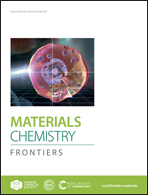Load-bearing study and interfacial interactions of hydroxyapatite composite coatings for bone tissue engineering†
Abstract
Hydroxyapatite (HAP) composite coatings on bio-implants have become very significant materials for orthopaedic applications. The additives in the HAP matrix can improve the wear resistance, mechanical strength, weak bonding and brittleness of the HAP. The present work reports comprehensive investigations of experimental and computational studies for commonly used bio-reinforcing agents, functionalized carbon nanotubes (CNT), graphene oxide (GrO) and hexagonal boron nitride (hBN), with HAP. The synergistic effect of lubrication of hBN and strong bonding between HAP and hBN resulted in a lower friction-of-coefficient (0.23) and reduced dissipation energy (4.6 × 10−4 J) for electrophoretically deposited HAP–hBN composite coating when compared to HAP–CNT, HAP–GrO and bare HAP. Furthermore, the high wear resistance with reduced wear volume (1.65 × 10−3 mm3) and wear rate (1.83 × 10−3 mm3 N−1 m−1) of the HAP–hBN composite coating exhibited its remarkable tribological properties for use in bone implants. Moreover, in order to facilitate some lucid insights into the interfacial bonding and nonbonding interactions (i.e. stability), structural, and electronic features of the HAP and HAP–based composite models (HAP–hBN, HAP–GrO, and HAP–CNT), comprehensive DFT are carried out. Remarkably, the HAP–BN composite model was stabilized by multiple Ca–N bonding interactions. With the employment of the electronic structure calculations approach, the HAP–hBN composite model was found to be the most stable among all three dimer complexes (HAP–hBN, HAP–GrO, and HAP–CNT), which was supported by the supramolecular approach (i.e. binding energy), QTAIM and NCI-plot tools. The biological studies of the HAP–hBN coating showed that the cell viability and antibacterial activity were greater than 80%, which shows the perfect bioactivity of the coating. Thus, the HAP–hBN composite coating with perfect hydrophilicity, wear resistance, biocompatibility and strong bonding compared to HAP–CNT and HAP–GrO can be used as an ideal implant material for bone tissue engineering.,



 Please wait while we load your content...
Please wait while we load your content...